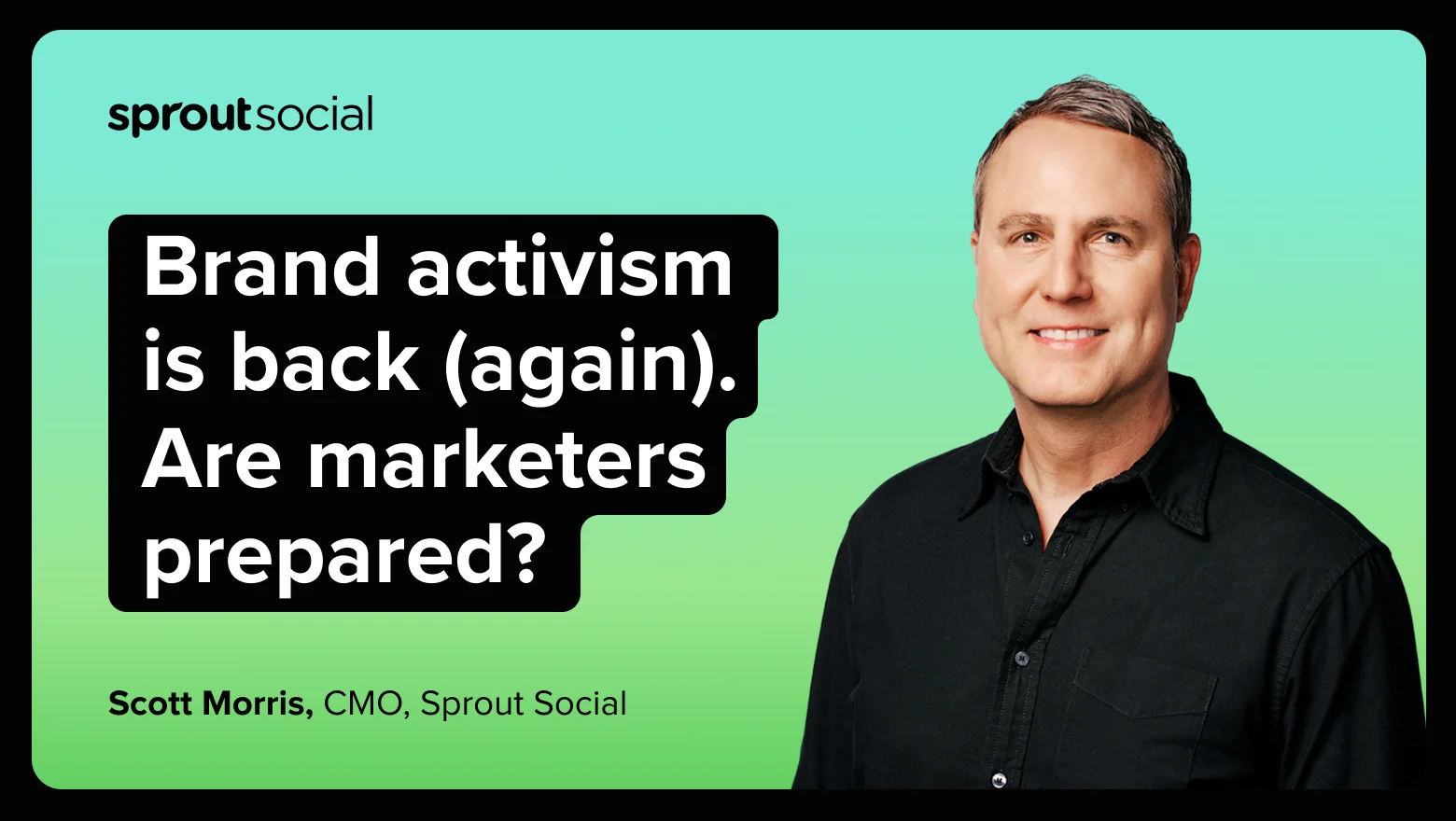Brand activism is back (again). Are marketers prepared?

Back in 2019 when Sprout published our Brands Get Real Report, 70% of consumers declared it was important for brands to take a stand on social and political issues. By 2023—thanks in part to woke-washing and increasingly divisive algorithms—consumers were over it. The 2023 Sprout Social Index™ found that only 25% said the most memorable brands speak about causes and news that align with their values.
The tide seems to be turning. Our Q3 2025 Pulse Survey shows that almost half of consumers are more likely to buy from companies that speak out about specific causes or topics in the news.
As consumer expectations shift (again) are marketers prepared? How should brands respond to renewed consumer enthusiasm for brand activism?
What is brand activism?
First, it’s important to define brand activism since it’s easily confused with corporate social responsibility (CSR). Brand activism is when companies take public stances on social, political and/or economic issues. These issues are typically controversial or polarizing, and the brand’s action is meant to drive societal change that stakeholders (including investors, employees and customers) want.
CSR is the action brands take privately to embed social and environmental responsibility practices into core business practices. Think initiatives to reduce their carbon footprint or support their community with philanthropy.
CSR is action brands take part in quietly. Brand activism is what a brand says loudly and publicly. While the two work together, they are very different.
Recent brand activism examples
Even though many brands have avoided brand activism lately, there are exceptions. In practice, brand activism looks like Levi’s loud and proud Pride Month campaign this year. The campaign came after shareholders voted to uphold the company’s DEI initiatives.

Or when Dove reinvigorated their Real Beauty campaign to stand against AI-generated and digitally distorted content. The decades-long campaign has aimed to change how women are represented in the media, and protect women and girls from unrealistic depictions.
Why audiences are coming back around to brand activism
What is it about this cultural moment that resurrected brand activism?
The data suggests the simultaneous rollback of DEI initiatives and other new policies, paired with a highly contentious global political climate and unstable economy, are driving forces. Especially for specific audiences.
The role of audience demographics
Certain demographics are more likely to care whether or not brands participate in activism. Per the Q3 2025 Pulse Survey, 63% of Gen Z and 57% of Millennials are more likely to buy from companies that speak out about specific causes. This holds true for the majority of Asian (61%), Black (63%), Latino (52%) and multi-race (55%) consumers, compared to only 35% of white consumers.
Political persuasion also plays a role. Liberals are most likely to say brand activism impacts their purchases (62%), compared to around 40% of Moderates and Conservatives.
The current social and political climate
2025’s historic election year ratcheted up political pressure worldwide. Changes in policy from new administrations are leading to organizations shifting their practices, which, in some cases, leads to consumer backlash.
For example, when US companies roll back DEI initiatives, over half of Gen Z and 36% of consumers overall say they will boycott.
Globally, people are using (and in many cases suppressing) their buying power to show where their loyalty lies, and forcing brands to “pick a side” on socially and politically fraught issues.
The turbulent economy
With a shaky global economy, consumers are scaling back and tightening their belts. Customer loyalty means more to brands in times like these, and loyalty is maintained by promoting shared values and a commitment to quality—which tend to go hand-in-hand.
Per the Index, consumers say their favorite brands on social have the highest quality products or services. At the same time, one in three consumers are concerned about brand content expressing social or political views that don’t align with their own, according to the Q3 2025 Sprout Pulse Survey. Consumers may be drawn in by your values and stick around for great products—or vice versa.
Take sustainable clothing company Patagonia. The brand has championed grassroots climate justice, eco-friendly practices and employee wellness since its founding, and regularly speaks out about issues like protecting the wilderness. They’re equally passionate about delivering the best performing gear on the market (so much so that they famously offer an ironclad guarantee). Together, this formula has made them one of the most profitable retailers in the world—likely to survive even the harshest economic downturns.
How to navigate brand activism, regardless of the cultural moment
Consumers have flip-flopped on brand activism many times in the last five years alone. Marketers shouldn’t simply ride the wave of public sentiment when deciding to take a stand. Doing so is a recipe for half-hearted initiatives that read like performative activism (because, well, they are).
Instead, companies should ask themselves these four questions before developing a long-term activism strategy.
What are your company values?
If your company doesn’t have clearly defined values—the beliefs that govern the way an organization does business—it’s imperative to articulate them as soon as possible. These guiding principles act as an “authenticity meter,” helping leaders make strategic decisions and employees and customers gauge whether the organization is living up to its beliefs. As an example, you can see how Sprout has defined and published our company values.
When you have values in place and communicate them to your team and customers, it’s easier to make aligned decisions when it comes to brand activism. But it’s important to remember that true activism begins internally, and your values should be applied inside-out, starting with your internal culture before moving external.
What is your brand’s risk tolerance?
Every company has a different risk threshold, and with any level of true activism, there’s an inherent level of risk involved. Not every cause aligns with industry norms or stakeholder expectations, and that can impact brand reputation or revenue (even if only in the short-term). In some cases, not speaking out becomes the bigger risk.
Understanding your risk tolerance helps determine how much criticism or controversy you’re prepared to handle and create a crisis comms plan that addresses potential pushback. By evaluating risk tolerance upfront, leaders can engage in activism that matches their capacity for fallout.
What will you act on and when?
News travels quickly in the era of the 24-hour attention economy, and social media has supercharged its pace. Companies need to have their finger on the pulse of the headlines and social conversation, and understand how their audience is reacting to the news. That’s where social intelligence comes in.
With the right tools, brands can surface real-time insights from social media that signal what issues your audience is increasingly vocal about. NewsWhip by Sprout Social, for example, uses predictive monitoring to determine how big a breaking news story could become and who’s dominating the conversation (across media publications and social), helping you make smarter decisions about how to respond.
It’s equally critical to consider how quickly you’ll make your statement. Will you take action within 24 hours after the news breaks? Or wait to see how the story develops?
How will your activism translate to action?
Finally, and most importantly, you need to create a plan for putting action into your brand activism, not just talk. Posting support or statements on social isn’t the same as making tangible change to your operations or supply chain. What are you willing to do (both proactively and reactively) to back up your words?
What the future holds for brand activism
Brand activism isn’t going anywhere. It’s evolving alongside culture and current events. Marketers who approach activism reactively risk coming across as performative, while those who ground their decisions in solid brand values, risk awareness and action can build real trust and loyalty.
The question isn’t just whether to engage in activism, but how to do so in a way that creates lasting impact.
For more of the latest consumer insights marketing leaders need to know, read about the state of social media in 2025.


Share